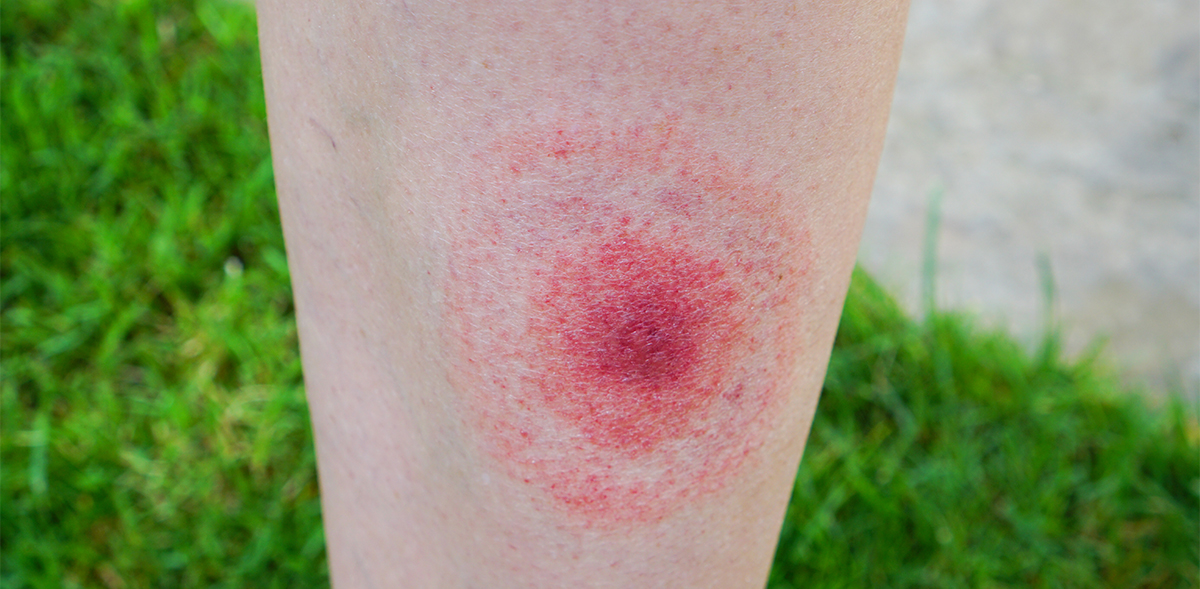- 1 (888) 843-5832
- info@dnaconnexions.com

How to Know If You’ve Been Bitten by a Tick: Signs and Symptoms
In this blog we will walk you through how to identify a tick bite and what symptoms to watch for in case the tick was infected with the bacteria that causes Lyme Disease.
There are over 900 species of ticks? Which ones do I have to worry about?
Ticks are small, blood-sucking parasites that belong to the arachnid family—the same group that includes spiders and mites. There are over 900 species of ticks, but only a few commonly bite humans. In North America, the most well-known include:
How Do Ticks Bite?
Ticks are most active during warmer months (spring through fall), especially in grassy, wooded, or bushy areas. They wait on the tips of grasses or leaves—a behavior called “questing”—and latch onto hosts when brushed against. Once on a host, a tick crawls to a suitable spot, pierces the skin with its mouthparts, and embeds itself to feed. Unlike mosquitoes, ticks can remain attached and feed for several days.
Ticks inject an anesthetic and an anticoagulant while feeding, which numbs the area and prevents clotting—making their bites painless and easy to miss initially.
How to Know If You’ve Been Bitten by a Tick
Because tick bites are often painless and ticks are small, you may not even realize you’ve been bitten until hours or days later. What are the signs?
1. Presence of a Tick on Your Skin
This is the most obvious. A tick attached to your skin looks like a small bump, and may resemble a mole or scab. If you look closely, especially using a magnifying glass, you’ll likely see the legs of the tick near the surface.
2. Red Bump or Small Lesion
Even if the tick has already detached or been removed, a red bump (similar to a mosquito bite) may remain at the site. This bump:
3. Bull’s-Eye Rash (Erythema Migrans)
One of the hallmark signs of a tick bite, particularly from a blacklegged tick, is a bull’s-eye rash that may indicate a potential Lyme Disease infection.
However, not everyone with Lyme disease develops this rash—only about 70–80% of cases. Still, it’s a major red flag and should prompt a medical visit.
4. Flu-like Symptoms
After a tick bite, some people may develop flu-like symptoms. These are often associated with a tick-borne illness, including:
What to Do After a Tick Bite
Monitor Your Health
Seek Medical Attention If:
How to Prevent Tick Bites
1. Dress Smart
2. Use Tick Repellent
3. Avoid Tick Hotspots
4. Check Yourself and Pets
Final Thoughts
Tick bites may be small, but their impact can be significant if left unchecked. Knowing how to identify a tick bite—and understanding what symptoms to monitor—can help you take timely action and reduce the risk of serious illness.
If you’ve been bitten or suspect a tick bite, don’t panic. Remove the tick properly, watch for symptoms, and consult a healthcare provider if needed. With awareness and proactive prevention, you can enjoy the outdoors without putting your health at risk.
If you or a loved one are struggling with Lyme Disease your path to healing may begin with the right test. One highly accessible and reliable option is the DNA ConneXions Lyme Disease Test, which uses a non-invasive urine sample to detect multiple Borrelia species with high specificity. This test is available for direct order and can be done from the comfort of your home. Take control of your health with DNA ConneXions and consider our highly rated direct test as your next step toward clarity and healing.

DNA ConneXions is a Biosafety Level 2 laboratory with a CLIA license encompassing the following specialties: Bacteriology, Mycology, Virology, and Parasitology.
Our lab offers accessible DNA testing to practitioners and individuals alike.
PHONE: 1 (888) 843-5832
EMAIL: info@dnaconnexions.com
4685 Centennial Blvd., Colorado Springs CO 80919
© 2025 dnaconnexions.com All Rights Reserved.